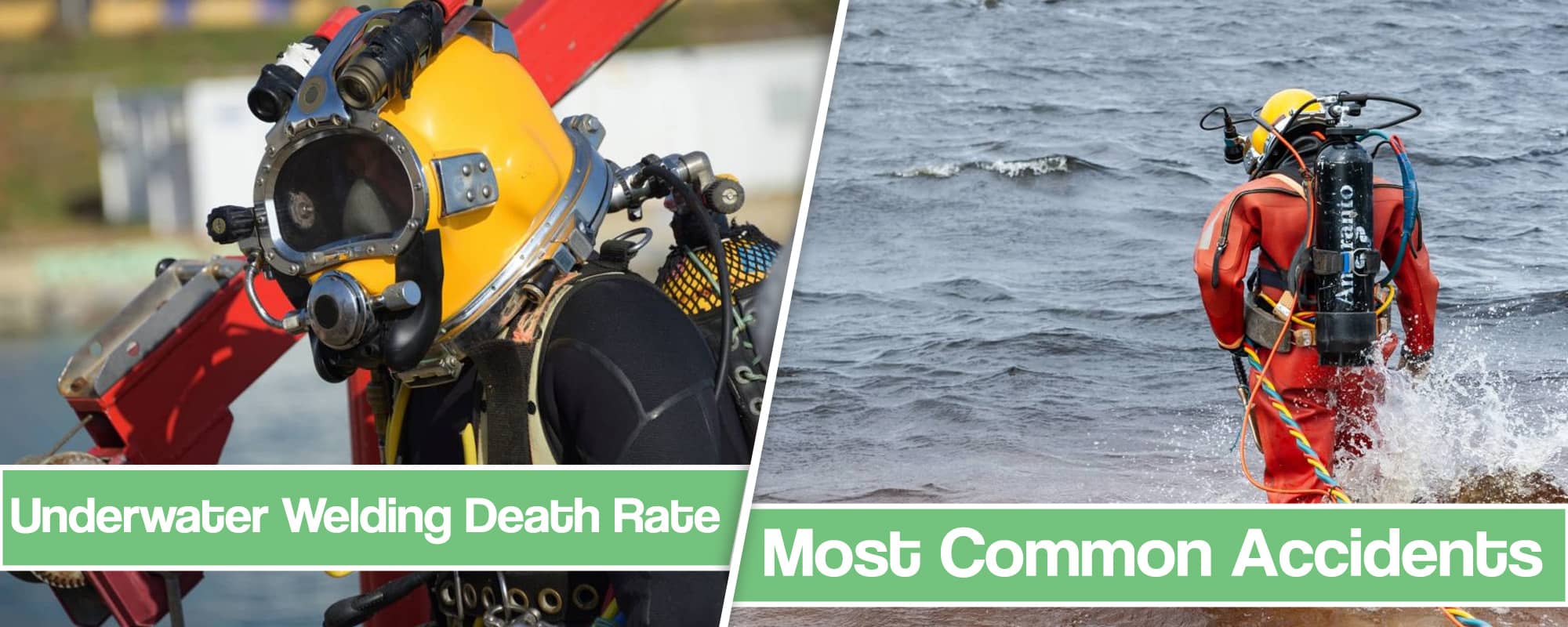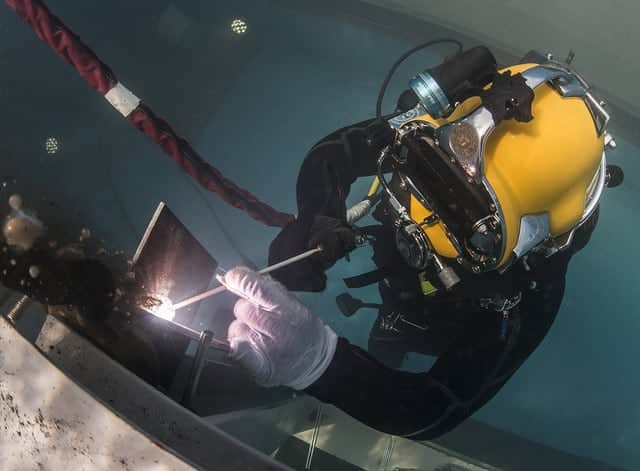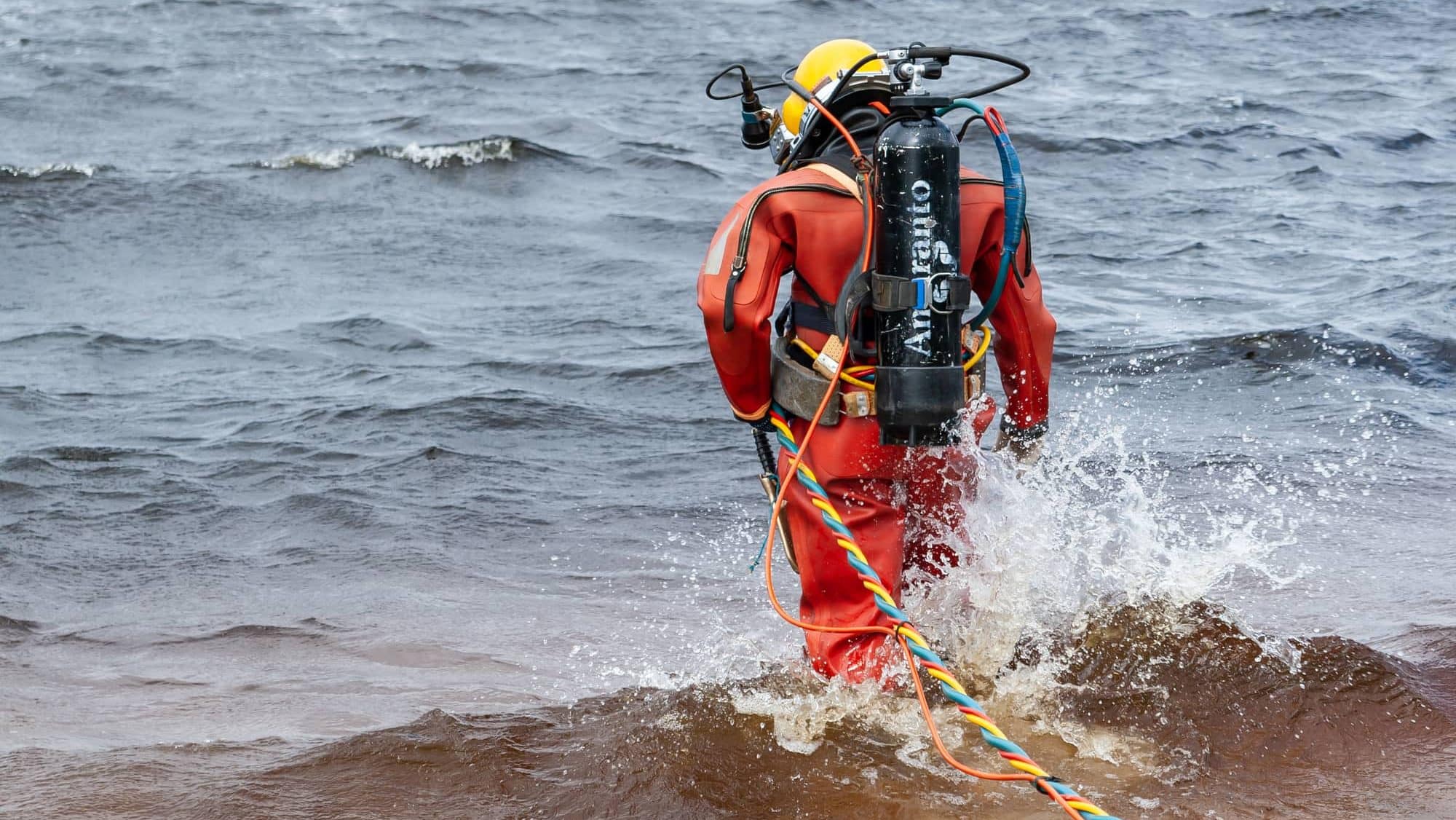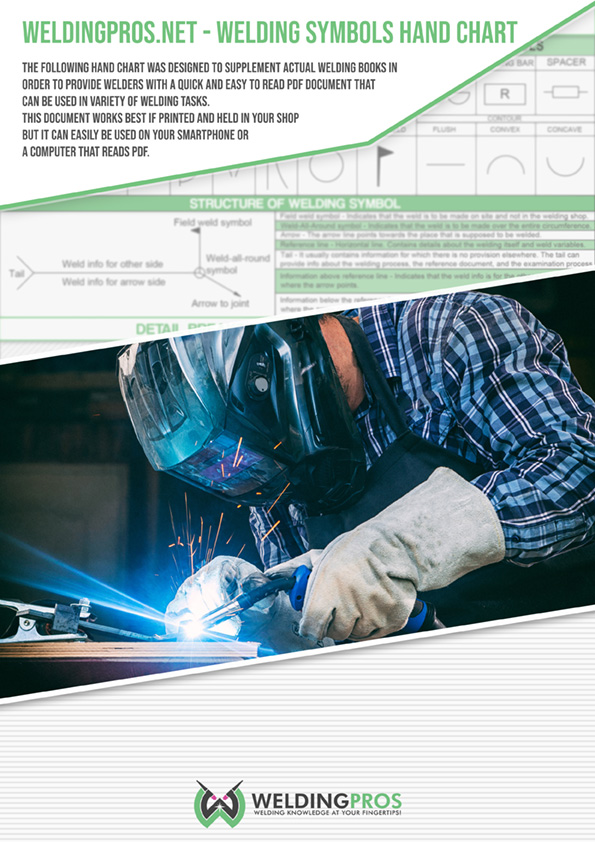Underwater welding may be a challenging skill to learn. As a result, few who can successfully become certified underwater welders can successfully do it.
Underwater welders work in construction, surveying, and repair in both fresh- and saltwater.

Therefore, the underwater welding death rate should be a guiding principle to know the responsibility attached to the trade. While the rigors of the job can be pretty demanding and the risks can be many, underwater welding can be an enriching career.
We’ll explain the underwater risk welders face every day, explain how accidents happen, and point out few critical notices. By the end of the article, you’ll be able to tell it is worth the risk.
Underwater Welder Risks
Underwater welders face various risks every day. Besides the high level of skill, the job requires nerves of steel, focus, and infinite concentration.
We don’t want to sound gloomy, but knowing the potential risks is essential as basic welding skills. Here are the risks commercial divers face and an explanation of why and how can they be dangerous as you work underwater:
- Decompression sickness
- Hypothermia
- Drowning
- Electrocution
Underwater welders also face various environmental risks, equipment failure, and underwater welding accidents.
![Underwater Welding Death Rate, Life Expectancy & Leading Causes of Death - [2025] 2 image of underwater welding risks](https://weldingpros.net/wp-content/uploads/2021/07/underwater-welding-risks-1024x870.jpg)
Decompression Sickness – The Bends
Generalized barotrauma, also known as the bends, represents the damage caused by a rapid decrease in the pressure while moving between different pressure zones. Divers use extra oxygen and nitrogen, where nitrogen or other harmful gases remains dissolved in the blood.
As the diver swims back to the surface, water pressure changes. If water pressure changes too fast, nitrogen separates from divers’ blood. That way, nitrogen bubbles form in blood and tissue. Dangerous bubbles are the leading cause of decompression sickness.
Hypothermia – Exposure to Cold
During deep commercial diving, where welders spend hours in the water, their bodies are exposed to cold temperatures. Low temperatures can be dangerous when breathing the oxygen and helium mixtures.
When deep diving, heat loss from the lungs can be higher than an actual suit, and insulated helmets cant provide. In addition, if there is no adequate gas heating for an extended period, lungs can freeze, and the diver may suffer from hypothermia.
![Underwater Welding Death Rate, Life Expectancy & Leading Causes of Death - [2025] 3 underwater welder in ice water](https://weldingpros.net/wp-content/uploads/2021/07/diver-in-ice-water-1-e1625743390971.jpg)
If the underwater welder’s body temperature goes below 95 F, specific physiological symptoms occur, and some of them can even be fatal. Moderate hypothermia can decrease reflexes and cause confusion, while severe symptoms can damage the heart, affect respiration ability and cause organ failure.
Drowning – It Can Even Happen to Professionals
Trust me when I say it, even experienced underwater welders can drown. Even by following all the safety precautions, welders can get entangled or pinned by their welding equipment.
There was a scientific study where 947 diving accidents between 1992 and 2003 are monitored. The study shows that 70 victims who drowned died because of diving-related injuries, equipment malfunctioning, air supply issues, and cardiac arrests.
Even today, drowning is one of the biggest risks that can occur even if you have a pack of a full oxygen tank or wear all the required safety equipment. To reduce risk, you should stay hydrated, make sure you don’t work tired, and inspect your oxygen tank.
Electrocution
The first thing you notice when talking about underwater welding is the link between electricity and water.
Even though the water itself is not such a great conductor, seawater contains ions of salts and metals that increase conductivity properties.
Welders use either alternating current or direct current power supply, insulated electrodes, and all the required equipment.

But, keep in mind that wet welding is much more exact science. So before welding underwater, divers take all the necessary precautions while joining metals in water. Safety measures include extra protection, a rubberized dry-suit, and specialized waterproof equipment. In addition, safety measures make commercial diving pretty safe from electric shock.
Keep in mind that underwater welding jobs also include salvage, inspections, and material installation. Therefore, all of the named jobs can be considered underwater construction.
Defense Technical Information Center (DTIC) conducted a study that shows that only one underwater welder died due to electric shock. This incident occurred in 1943 in the Deep Sea Diving School.
Environmental Hazards
Welders underwater work in many different environments, including offshore oil rigs, dams, oceans, lakes, rivers. Unfortunately, every single environment contains potential dangers that less experienced welders are not ready to deal with.
One scientific study shows that 36% of underwater welding deaths occurred because of difficult water conditions. These are some of the factors that increase commercial diving risks and reduce their life expectancy:
- Rough water conditions
- Underwater obstacles
- Explosions
- Strong currents
- Poor visibility
- Surges in a wave movement
One of the rare but potential hazards is explosions. They occur once hydrogen and oxygen combine in the surrounding water, creating gas pockets. Once they ignite, gas pockets will cause an explosion. In addition, fuel stored in marine vessels and offshore oil rigs can also ignite, and lead to death or severe injuries.
Differential Pressure (Delta P Deaths)
Differential pressure is responsible for 7% of all reported underwater welding accidents. So that rate puts this hazard on top of the list. Delta P is standard when water moves from a high-pressure to a lower pressure area. Accidents happen when welders open a valve, cut into space, or engage a pump.
The height difference between the two bodies generates a suction force. Therefore, the more significant the height or pressure difference, the more dangerous the suction force is as the power is more substantial.
The biggest problem is that you cannot detect potential Delta P situations visually. It all happens very suddenly, and trying to pull out your arm or a leg, feels like trying to lift the car with it.
To reduce the risk, welders must first be aware of it.
When there is a potential Delta P situation in the work area, the fluid mechanic calculation will determine the safe zone. Usually, before the work, you’ll get all the required information. However, if you still doubt, you can use Continuity Equation, Torricelli’s Equation, and the Drag Equation to calculate the safe zone by yourself.
Keep in mind that Delta P hazard is present in your domestic swimming pool or even spa, so you don’t need to be an underwater welder to be at risk.
Underwater Welding Death Rate – How Risky is It?

Various studies show different underwater welding death rates. The first one was released by the Center for Disease Control and Prevention (CDC), which published the data monitored between 1989 and 1997. According to their numbers, there was an average of five underwater welder deaths in nearly ten years.
According to past OSHA reports, there are an average of 6-13 diving-related deaths every year. Unfortunately, there are no recent statistics that monitor the underwater welder’s annual death rate. In addition, OSHA safety standards on commercial diving aren’t updated since 1978.
Nevertheless, there are promises that new safety protocols are being developed and implemented every year. Still, older studies show that drowning is a leading cause of underwater welders deaths, while they state that approximately 11 underwater welders die every year.
While the Bureau of Labor Statistics does not track fatality rates of underwater welders, a study conducted in 2018 shows that for every 100,000 workers in the US, about 3.5 of them die on their job every year.
The study identified five jobs that come with potential risks. Underwater welding was listed as the top dangerous profession with nearly a 15% fatality rate, followed by aeronautics with 5%, logging with 0.13%, fishing with 0.12%, and airplane piloting with a 0.07% fatality rate.
How Underwater Welders Die?
According to statistics, underwater welders are more likely to die during inspection rather than underwater welding. The CDC study we mentioned earlier implies drowning is the leading cause of underwater welding deaths. Today, that’s still the case, but drowning occurs differently while welding.
Another study examined diver populations in the Gulf of Mexico from 1968 to 1975 and in the British sector of the North Sea from 1971 to 1978. There were 900 reported Gulf of Mexico and 700 North Sea deaths. Leading causes of reported underwater welder deaths are listed in the table. In addition, the table explains some of the most common ways that welders lose their lives.
Long story short, proper training and preparation are crucial for each underwater welding job, as their life depends on it. Situations and accidents occur differently, and only experience and adequate preparation can save lives and reduce the death rate.
| Disabling Injury | By the time the rescue team reaches the diver, they are already out of the air |
| Harmful/Disabling Event | Diver panics, which leads to breaking the line |
| Triggering Event | Diver cords are twisted |
| Host factors | The main cause is level of experience, sometimes behavioral dysfunction is accounted |
| Environmental factors | Supervisor/tender errors, equipment failure |
Underwater Welders Life Expectancy
The Divers Association study observed 382 documented underwater welding casualties. However, only 251 of them reported the age of deceased divers.
With 98% of confidence, the study reports that the deceased divers were between ages 33 and 42. So while most of the underwater welders start their courses at the age of 20, they’ve most likely been working for 13-22 years which should be a guideline to life expectancy.
These results show that the cause of death is not dependant on the experience but other factors as well. The two most essential variables that keep occurring include proper training and safety procedures provided by the company.
Is Welding Underwater Worth The Risk?
The first benefit welding underwater offers a significant salary. According to the American Welding Society, underwater welding can provide an annual salary of up to $100,000-$200,000. Besides that, you can always travel the globe and visit different remote sites.
One thing worth pointing out is that welders earn their commercial diver certificate in under a year. So when compared to professions like doctors and lawyers, you can start making a big buck pretty fast.
![Underwater Welding Death Rate, Life Expectancy & Leading Causes of Death - [2025] 6 is underwater welding worth the risk](https://weldingpros.net/wp-content/uploads/2021/07/underwater-welding-is-it-worth-the-risk-1-e1625744214876.jpg)
.It is a highly paid occupation that doesn’t require time, resources, or a university degree. Also, underwater welding is a highly needed profession, and the demand will rise in the foreseeable future.
So if you are ready to take the risk, this high-skilled job is the right career for you. Keep in mind that many law firms offer free case evaluation in case of severe injuries.
Underwater Welding Requirements and Training
Underwater welding involves two types of welding: hyperbaric chamber (dry welding) and wet welding. Hyperbaric welding is done in the deep water where welders are in an air-regulated chamber. That way, an electrode is not touching the water as they work in a dry environment. In wet welding, you join metals in a wet environment.
To start working in these harsh conditions, you must first complete specialized training. In addition, experienced instructors teach you how to act in a different situation and do your work correctly.
Extensive training is not cheap, and it may be a limitation for some welders. Nevertheless, if you are a dedicated worker, you can repay the scholarship after a couple of jobs. Before you make a choice, make sure that diving school is accredited by proper welding organizations.
Many studies show that physically fit welders handle dangerous situations better. Many companies even require a “Fit for duty” certificate. It would be best if you got it before you consider starting your first job. Some companies even have their welder stress safety protocols and many safety training hours. Keep in mind that underwater welders never dive alone!
Conclusion
Underwater welding offers the opportunity for travel, adventure, and lucrative pay. Salaries in underwater welding can vary widely. But it can be more lucrative than welding strictly on dryland due to the training involved, the environment they work in, and the amount of risk involved. If you are ready to take the risk, you can earn quite a few bucks. Welders that go through training reduce the risk of possible injuries and hazards.
Resources:
- Commercial Diving Safety Standards, by Occupational Safety and Health Administration (OSHA)
- Commercial Diving Fatalities, by M E Bradly at PubMed
- Commercial Diving Deaths and What They Tell Us, by Kyra Ritcher
- DAN Annual Diving Report 2019, by Pater J. Denoble et al. at NCBI
- Deaths Associated With Commercial Diving, by CDC
- Documented Commercial Diving Accidents, by OSHA
- National Census of Fatal Occupational Injuries in 2019, by Bureau of Labor Statistics




